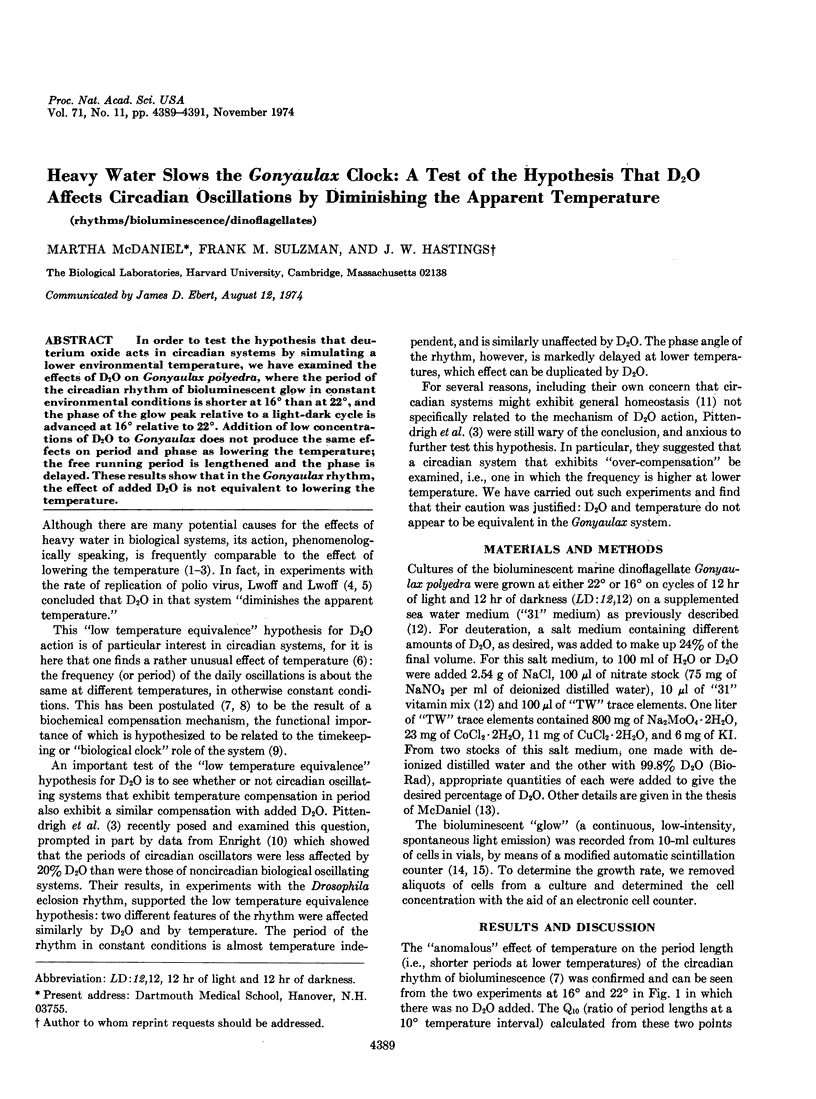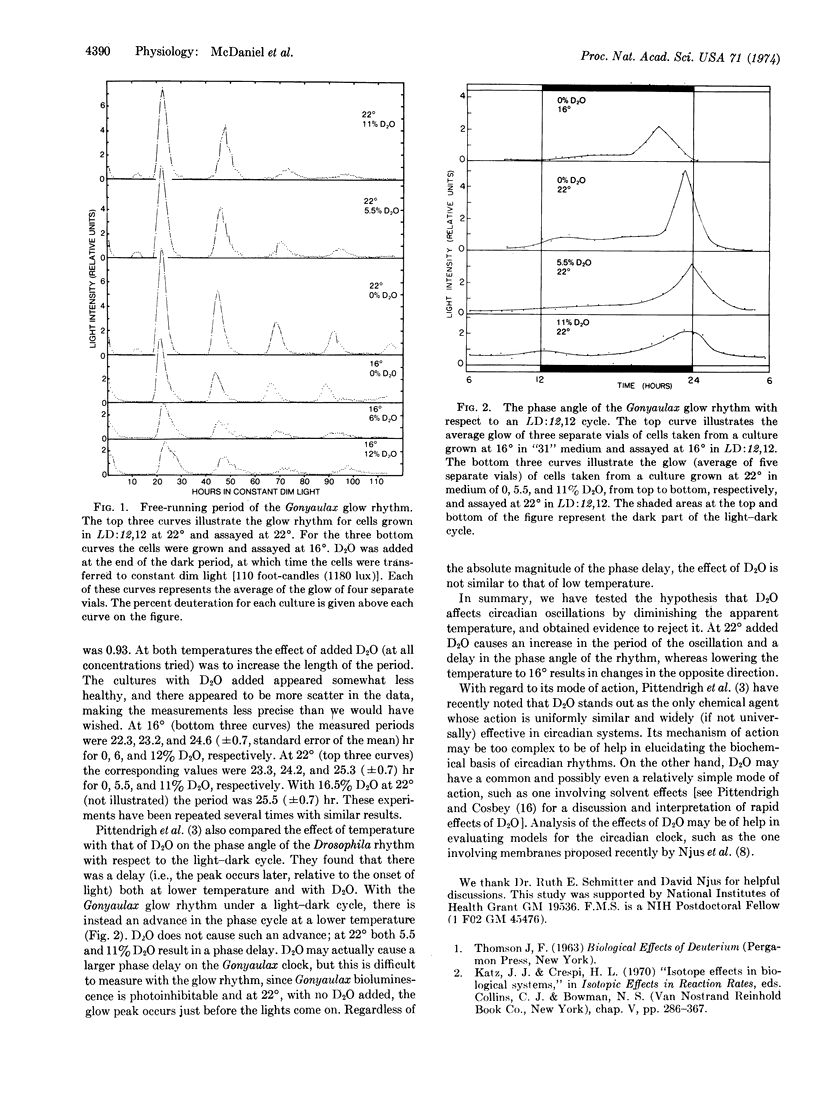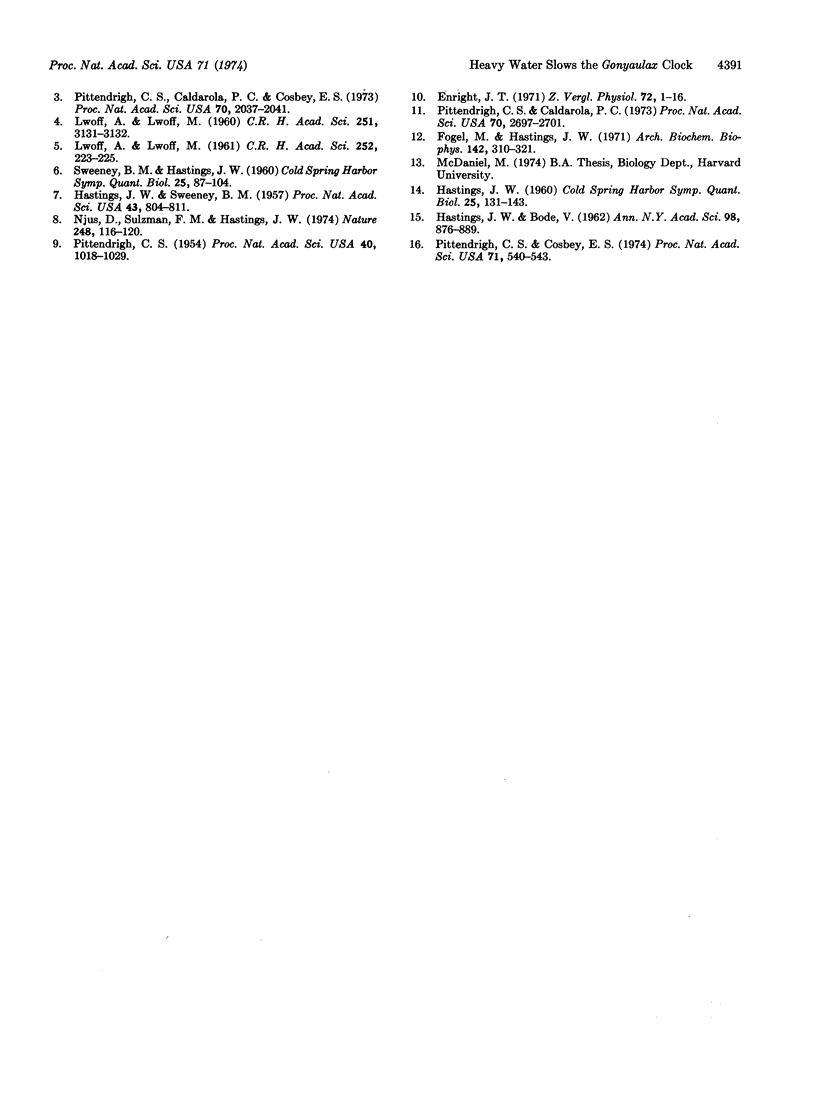Abstract
In order to test the hypothesis that deuterium oxide acts in circadian systems by simulating a lower environmental temperature, we have examined the effects of D2O on Gonyaulax polyedra, where the period of the circadian rhythm of bioluminescent glow in constant environmental conditions is shorter at 16° than at 22°, and the phase of the glow peak relative to a light-dark cycle is advanced at 16° relative to 22°. Addition of low concentrations of D2O to Gonyaulax does not produce the same effects on period and phase as lowering the temperature; the free running period is lengthened and the phase is delayed. These results show that in the Gonyaulax rhythm, the effect of added D2O is not equivalent to lowering the temperature.
Keywords: rhythms, bioluminescence, dinoflagellates
Full text
PDF


Selected References
These references are in PubMed. This may not be the complete list of references from this article.
- Fogel M., Hastings J. W. A substrate-binding protein in the Gonyaulax bioluminescence reaction. Arch Biochem Biophys. 1971 Jan;142(1):310–321. doi: 10.1016/0003-9861(71)90289-x. [DOI] [PubMed] [Google Scholar]
- HASTINGS J. W., BODE V. C. Biochemistry of rhythmic systems. Ann N Y Acad Sci. 1962 Oct 30;98:876–889. doi: 10.1111/j.1749-6632.1962.tb30605.x. [DOI] [PubMed] [Google Scholar]
- HASTINGS J. W. Biochemical aspects of rhythms: phase shifting by chemicals. Cold Spring Harb Symp Quant Biol. 1960;25:131–143. doi: 10.1101/sqb.1960.025.01.012. [DOI] [PubMed] [Google Scholar]
- Hastings J. W., Sweeney B. M. ON THE MECHANISM OF TEMPERATURE INDEPENDENCE IN A BIOLOGICAL CLOCK. Proc Natl Acad Sci U S A. 1957 Sep 15;43(9):804–811. doi: 10.1073/pnas.43.9.804. [DOI] [PMC free article] [PubMed] [Google Scholar]
- LWOFF A., LWOFF M. [Effects of heavy water on the development of poliovirus as a function of temperature]. C R Hebd Seances Acad Sci. 1961 Jan 4;252:223–225. [PubMed] [Google Scholar]
- Njus D., Sulzman F. M., Hastings J. W. Membrane model for the circadian clock. Nature. 1974 Mar 8;248(5444):116–120. doi: 10.1038/248116a0. [DOI] [PubMed] [Google Scholar]
- Pittendrigh C. S., Caldarola P. C., Cosbey E. S. A differential effect of heavy water on temperature-dependent and temperature-compensated aspects of circadian system of Drosophila pseudoobscura. Proc Natl Acad Sci U S A. 1973 Jul;70(7):2037–2041. doi: 10.1073/pnas.70.7.2037. [DOI] [PMC free article] [PubMed] [Google Scholar]
- Pittendrigh C. S., Caldarola P. C. General homeostasis of the frequency of circadian oscillations. Proc Natl Acad Sci U S A. 1973 Sep;70(9):2697–2701. doi: 10.1073/pnas.70.9.2697. [DOI] [PMC free article] [PubMed] [Google Scholar]
- Pittendrigh C. S., Cosbey E. S. On the very rapid enhancement by D2O of the temperature-tolerance of adult Drosophila. Proc Natl Acad Sci U S A. 1974 Feb;71(2):540–543. doi: 10.1073/pnas.71.2.540. [DOI] [PMC free article] [PubMed] [Google Scholar]
- Pittendrigh C. S. ON TEMPERATURE INDEPENDENCE IN THE CLOCK SYSTEM CONTROLLING EMERGENCE TIME IN DROSOPHILA. Proc Natl Acad Sci U S A. 1954 Oct;40(10):1018–1029. doi: 10.1073/pnas.40.10.1018. [DOI] [PMC free article] [PubMed] [Google Scholar]
- SWEENEY B. M., HASTINGS J. W. Effects of temperature upon diurnal rhythms. Cold Spring Harb Symp Quant Biol. 1960;25:87–104. doi: 10.1101/sqb.1960.025.01.009. [DOI] [PubMed] [Google Scholar]


